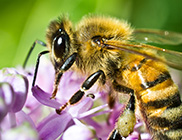
“Bee” is one of the common names applied to a diverse group of insects. Because many people have no interest in getting too close to what may be a stinging insect, flying insects that are similar in coloration and behavior, such as bees, wasps and hornets, are often collectively called ‟bees.” As you can see in the following pictures of bees, there are visual differences that are obvious to most people.
WHAT IS THE DIFFERENCE BETWEEN A BEE AND A WASP?
All bees and wasps are members of the order Hymenoptera (derived from ancient Greek, meaning ‟membrane wing”). Essentially all bees develop on a diet of pollen and nectar. They are almost always hairy-bodied, which is an advantage when they are collecting pollen. Wasps are primarily predators of other arthropods and are relatively hairless. Wasps can sting multiple times, whereas a bee can usually sting only once.
HOW CAN I TELL IF IT IS A HONEY BEE?
The best known bee species is the European honey bee, which, as its name suggests, produces honey. Honey bees represent only a small fraction of the roughly 20,000 known species of bees. Some other types of related bees produce and store honey, but only members of the genus Apis are true honey bees.
Coloration varies, but generally honey bees have bands of amber to brown hairs alternating with black stripes, as you can see in the bee pictures. Some bees may appear mostly black. They are about one-half to three-fourths of an inch in size. An established hive generally has 10,000 to 50,000 bees and may contain 20 to 80 lbs. of honey.
HOW CAN I TELL IF A BEE IS A “KILLER BEE”?
Africanized honey bees (AHB), often called ‟killer bees,” look almost identical to the European honey bee. Even when looking at detailed bee images, it is almost impossible to tell them apart. Though visually similar, their behavior is markedly different. The AHB are very protective of their home and can attack to defend it in great numbers. They may stay aggressive for days after being disturbed. Africanized honey bees are primarily found in California, Nevada, Arizona, Texas and Florida.
WHAT IS THE DIFFERENCE BETWEEN A HONEY BEE AND A BUMBLE BEE?
Bumble bees are about twice the size of honey bees, and colonies are smaller, growing to as few as 50 individuals in a nest. Female bumble bees can sting repeatedly, but are not typically aggressive toward humans. Bumble bees have round bodies covered in soft hair (long, branched setae), called pile, making them appear and feel fuzzy. They also have warning coloration, often consisting of contrasting bands of color. Bee images show that different species of bumble bee in a region often resemble each other, and that they may be more brightly colored in some regions.
WHAT IS THE DIFFERENCE BETWEEN A BUMBLE BEE AND A CARPENTER BEE?
Carpenter bees average one inch in length like the bumble bee. Their flight is faster than a bumble bee's, and may appear similar to a hummingbird’s flight pattern. Carpenter bees are solitary bees burrowing nearly perfect round holes the size of a dime or penny into wood patio covers, eaves and other places.




